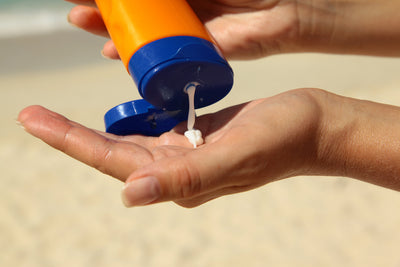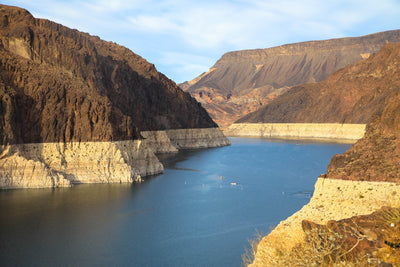Emily Driehaus | Science Communication Intern
Oxybenzone is a common sunscreen ingredient that has been shown to have negative impacts on human health and the environment. Evidence has shown that it can contaminate drinking water after being washed down the drain while showering off sunscreen.
What is Oxybenzone?
Oxybenzone is a UV filter used in sunscreen and other cosmetics. It absorbs UV rays from the sun and helps prevent them from penetrating the skin and causing sun damage. While it does help protect our skin against the sun, it has implications for both our health and the environment, particularly aquatic life.
Oxybenzone and Marine Life
Much of the concern regarding oxybenzone began when researchers noticed damage to coral reefs near beaches with many visitors. As sunscreen gets sloughed off the skin by the water and sand, it can make its way into the ocean and harm aquatic life. Coral reefs are especially susceptible to damage, as oxybenzone can harm normal growth and development, damage DNA and put them at an increased risk of bleaching.
Health Implications of Oxybenzone
As research into oxybenzone has continued, it has been designated as an endocrine disruptor. Endocrine disruptors interfere with normal hormonal processes in the body and can impact the reproductive system. Most research on oxybenzone in the human body has focused on absorption through the skin rather than ingestion, but more evidence has shown that oxybenzone is present in drinking water, especially in communities near large bodies of water.
How Does Oxybenzone Get Into Drinking Water?
After a day at the beach, most individuals hop in the shower to rinse off the sunscreen and sand that has accumulated on their skin throughout the day. When this water goes down the drain, it goes to wastewater treatment plants to be treated before being released into water sources, which can be used for drinking water. Wastewater treatment plants and drinking water facilities lack the ability to filter out endocrine disruptors like oxybenzone, so it ends up in drinking water consumed by the public. A study looking at oxybenzone in Honolulu tap water showed that individuals consume between 0.8-1.2 micrograms of oxybenzone a day from drinking water. This concentration is not particularly harmful to fully grown adults, but can have a greater impact on children, infants and developing fetuses.
Regulations on Oxybenzone
The previously mentioned study was submitted as part of testimony on a bill that would ban the sale of sunscreens containing oxybenzone in the state of Hawaii. The bill passed in 2018 and went into effect at the beginning of this year. The city of Key West, Florida has also enacted a ban on sunscreens with oxybenzone in an effort to protect coral reefs. These bans are not without controversy, as skin damage from UV rays can lead to skin cancer and banning sunscreens with oxybenzone leaves individuals in these areas with one less form of sun protection.
What Should I Do if I’m Concerned About Oxybenzone in my Water?
Carbon water filters are able to filter out oxybenzone and other endocrine disruptors. Using sunscreen with ingredients like zinc oxide or titanium dioxide rather than oxybenzone can also reduce your overall exposure. Switching sunscreens will also help protect aquatic life when you swim in bodies of water like lakes or oceans.
Other Articles We Think You Might Enjoy:BPA and Phthalates: Are These Two Endocrine Disruptors in Your Water?
Trump's "Dirty Water Rule" to be Revised
Drinking Water Supplies Risk Contamination from Toxic Wastewater Ponds











